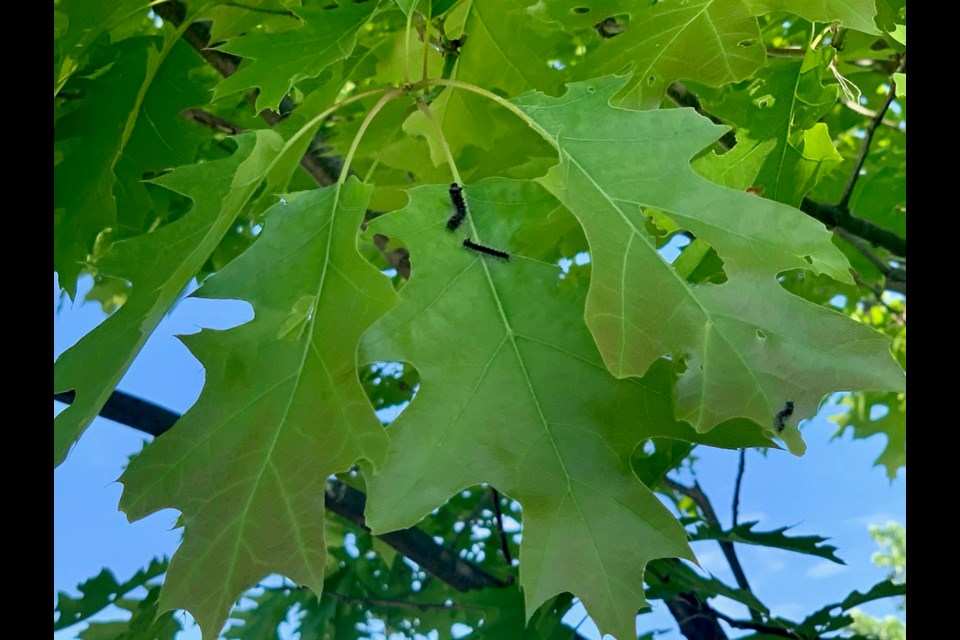Lymantria dispar dispar have been cropping up in Newmarket, with local experts warning we are facing the start of an outbreak.
The invasive species has also been called European gypsy moth, however the Latin name or shortened term LDD, are considered to be more socially acceptable, prompting the town to shift its reference to the pesky invader by its Latin name.
Joerg Hettman with Newmarket’s forestry department says this is just the beginning for the insect infestation.
In Newmarket, he said, “This year is the first year of the peak of the outbreak, where you really start seeing defoliation of the trees.”
LDD, which has four stages in its life cycle, is currently in the caterpillar stage, which is the second one.
This period, which lasts from early May into mid-July, is also one of the most destructive stages.
#Gypsymoth / Lymantria dispar dispar (#LDD) caterpillars are starting to hatch! We continue to monitor & treat our highest risk street trees. Help protect your trees by wrapping them w/ burlap or contacting a licensed tree care company. Learn more: https://t.co/HUkNuVMPUf pic.twitter.com/rGKumvT9x1
— York Region (@YorkRegionGovt) May 28, 2021
The caterpillars will completely eat all the leaves on a tree, which is called defoliation, and while it's unpleasant most of the time, it’s not detrimental to the trees.
“A tree that is healthy can handle several years of defoliation and not die,” Hettman said, “It is messy through the months of May, June and July in terms of, you get the defoliation and it really looks weird in the forest.”
He added, “It’s a nuisance but the forest should survive.”
So far, they have noticed outbreaks are heavy west of Yonge Street in Newmarket, where there are a lot of wooded areas, but they haven’t planned any widespread treatments.
One potential fix for LDD is a bacteria called BTK that is sprayed at the ground of one specific tree. In the past, it has been used in aerial spraying in some municipalities but there are several factors that have to be considered before that happens, according to Hettman.
“Our population dynamics right now is not at a stage where spraying is advisable,” he said.
Instead, the town is focused on collecting data about the outbreak to understand where and how it is spreading. However, they have used burlap to treat specific trees on town boulevards and in some parks this spring.
“It basically creates a barrier where the caterpillars collect underneath the burlap, so you hang it three feet off the ground or four feet off the ground so what it does is it provides an opportunity to safely collect caterpillars,” Hettman said.
He said this is something residents can do themselves, but advises they wear gloves and long sleeves as the hairs on the caterpillars are an irritant and can cause welts on people’s arms.
The Town of Newmarket will be providing free burlap to residents to create traps for the caterpillars from June 9 to 18 (while supplies last) Monday to Friday from noon until 3 p.m. through a curbside pick-up drive through at the municipal offices. Residents will be provided three sheets of burlap and an information guide on how to set up burlap traps.
In Aurora, residents can pick up free burlap at the municipal office to deal with any infestations on their own property.
The giveaway has been met with “overwhelming interest,” according to the town’s Facebook page.
Despite the demand, experts say the LDD isn’t actually that bad this year.
Jeff Bond, who is Newmarket’s manager of parks and property services, said that compared to other spots in York Region, Newmarket’s population of the pests is pretty low.
But it’s not going to stay that way.
“It’s not as bad,” he said. “Next year is going to be worse, is what we’re expecting.”
Hettman agreed this is “just the beginning” and that Newmarket residents could be dealing with the onslaught for the next two years at least.
“So what you can expect is west of Yonge Street, it will get much worse, because you already have the start of an outbreak,” he said. “What you see this year west of Yonge Street, you’re likely going to see east of Yonge Street where you have pockets and where you have an increase of population.”
However, he said they will have a better idea in the fall, after the data has been collected.
As well as using burlap, he advises residents to consult the town’s website, which has a lot of information and a new reporting feature coming soon.
“We are about to introduce an interactive portion of it where people can report sightings, similar to what the website has right now for sightings of coyotes,” Hettman said.
He added that this resident-sourced data will also help them understand where LDD is spreading and plan for future outbreaks.
